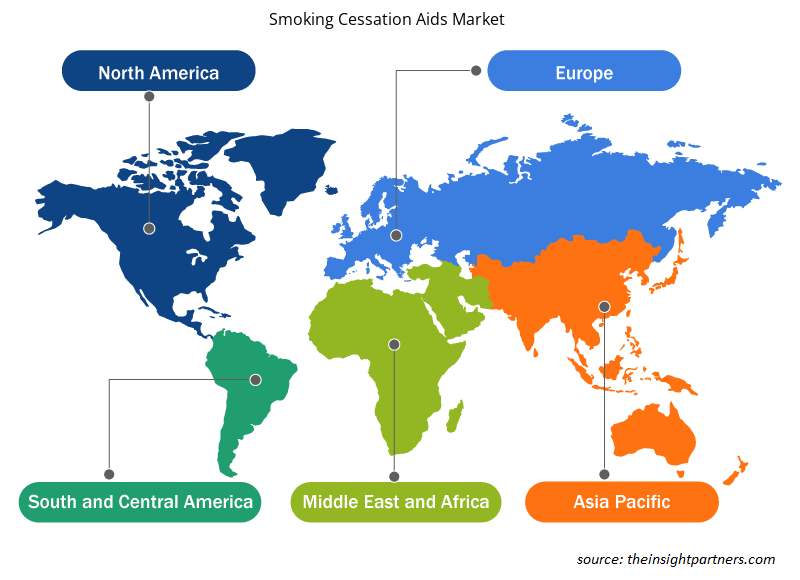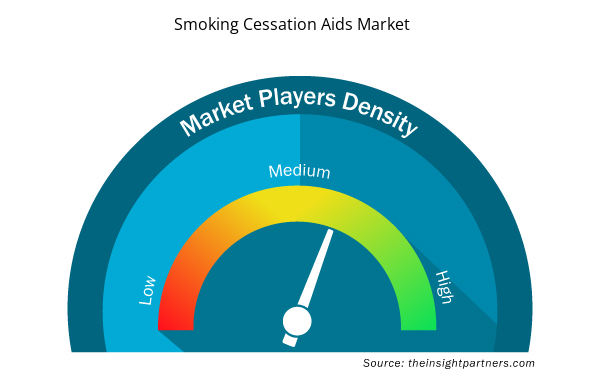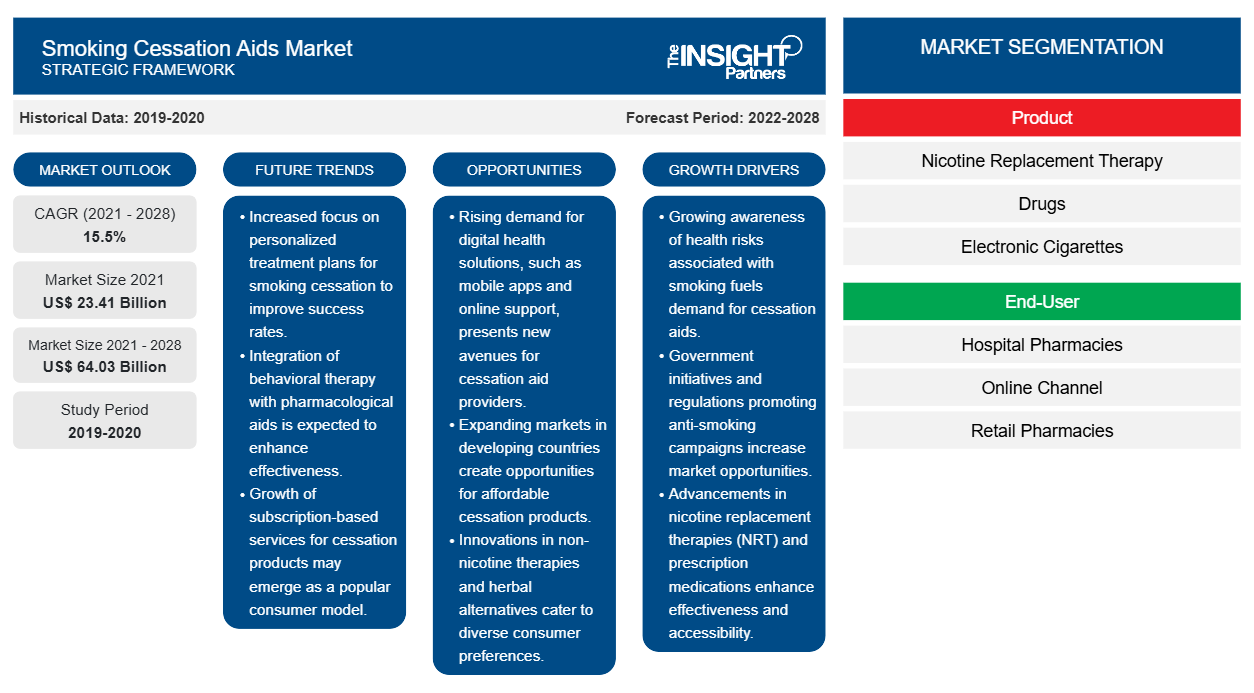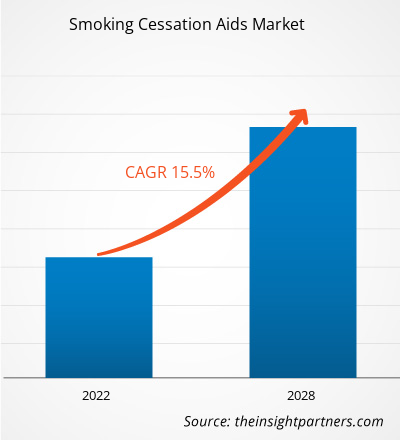Der Markt für Hilfsmittel zur Raucherentwöhnung soll von 23.413,08 Millionen US-Dollar im Jahr 2021 auf 64.032,30 Millionen US-Dollar im Jahr 2028 anwachsen. Der Markt soll von 2021 bis 2028 mit einer durchschnittlichen jährlichen Wachstumsrate von 15,5 % wachsen.
Die wichtigsten Wachstumsfaktoren für diesen Markt für Raucherentwöhnungshilfen sind die zunehmende Abhängigkeit vom Tabakrauchen und die zunehmende Zahl von Kampagnen zur Reduzierung des Rauchens und der Tabakabhängigkeit. Die steigenden Kosten für die Entwicklung von Nikotinersatztherapien dürften das Marktwachstum in den kommenden Jahren jedoch in gewissem Maße bremsen.
Markteinblicke
Steigende Abhängigkeit vom Tabakrauchen
Nikotin ist eine stark süchtig machende Substanz, die in der Tabakpflanze vorkommt. Das Rauchen von Tabak ist nachweislich in allen Formen gefährlich, da es zu chronischen Gesundheitszuständen, vermeidbaren Krankheiten, Todesfällen und Behinderungen führen kann. Laut der Weltgesundheitsorganisation (WHO) führen rauchbedingte Störungen in den USA jährlich zu etwa 435.000 Todesfällen, was etwa einem Fünftel aller Todesfälle im Land entspricht. Laut den Centers of Disease Control and Prevention (CDC) rauchten im Jahr 2018 fast 40 Millionen Erwachsene in den USA Zigaretten. Darüber hinaus verwendeten etwa 4,7 Millionen Mittel- und Oberstufenschüler mindestens ein Tabakprodukt und etwa 1.600 junge Menschen unter 18 Jahren rauchten in den USA ihre erste Zigarette. Jedes Jahr sterben fast eine halbe Million Patienten an durch das Rauchen verursachten Krankheiten. Die US-Regierung gibt rund 225 Milliarden US-Dollar für die medizinische Versorgung von Patienten mit rauchbedingten Erkrankungen aus. Daher ist die Verbreitung des Tabakrauchens in vielen Ländern der Welt hoch.
Passen Sie diesen Bericht Ihren Anforderungen an
Sie erhalten kostenlos individuelle Anpassungen an jedem Bericht, einschließlich Teilen dieses Berichts oder einer Analyse auf Länderebene, eines Excel-Datenpakets sowie tolle Angebote und Rabatte für Start-ups und Universitäten.
- Holen Sie sich die wichtigsten Markttrends aus diesem Bericht.Dieses KOSTENLOSE Beispiel umfasst eine Datenanalyse von Markttrends bis hin zu Schätzungen und Prognosen.
In verschiedenen europäischen und asiatischen Ländern ist das Szenario ähnlich. Griechenland, Bulgarien, Frankreich und Kroatien sind die Länder mit dem höchsten Tabakkonsum in Europa. Laut dem Institute of Health Metrics and Evaluation ist Rauchen in Europa eine sehr verbreitete Sucht, da über 20 % der Erwachsenen über 15 täglich rauchen. Darüber hinaus sind laut World Population Review die höchsten Raucherquoten in Südostasien und auf dem Balkan in Europa zu verzeichnen. Der WPR weist auch darauf hin, dass in verschiedenen süd- und südostasiatischen Ländern die Raucherquoten unter Männern tendenziell hoch sind. In Indonesien beispielsweise lag die Raucherquote unter Männern im Jahr 2018 bei 76,20 %. Die steigende Zahl der Raucher weltweit treibt also das Wachstum des globalen Marktes für Raucherentwöhnungshilfen voran.WPR also suggests that in various South and Southeast Asian countries, the smoking rates tend to be high among men. For instance, in Indonesia, the smoking rate among males was 76.20% in 2018. Thus, the rising number of smoking populations across the world drives the growth of the global smoking cessation aids market.
Produktbasierte Einblicke
Der Markt für Hilfsmittel zur Raucherentwöhnung ist je nach Produkt in Nikotinersatztherapie, Medikamente, elektronische Zigaretten und andere unterteilt. E-Zigaretten gelten als gesunde Alternative zu Tabakzigaretten und werden im Prognosezeitraum voraussichtlich das am schnellsten wachsende Segment sein. E-Zigaretten sind eine wirksame Alternative zur Reduzierung von mit Tabak verbundenen Gesundheitsproblemen, während Nikotinersatztherapien am besten zur Raucherentwöhnung geeignet sind. E-Zigaretten stellen eine potenzielle Bedrohung für Zigaretten auf Tabakbasis dar. Darüber hinaus ist der Konsum von E-Zigaretten im Vergleich zu normalen Zigaretten weniger schädlich, es entsteht kein Rauch und es besteht keine Gefahr des Passivrauchens, die Verwendung ist sogar in Nichtraucherbereichen erlaubt, der Nikotingehalt ist unterschiedlich und die Verfügbarkeit in verschiedenen Geschmacksrichtungen sind einige der wichtigsten Antriebsfaktoren für den E-Zigarettenmarkt. Darüber hinaus ist die zunehmende Beliebtheit von E-Zigaretten aufgrund ihrer elektronischen Funktion der Hauptfaktor, der zur steigenden Nachfrage beiträgt.
Endbenutzerbasierte Erkenntnisse
Basierend auf dem Endverbraucher ist der Markt für Hilfsmittel zur Raucherentwöhnung in Krankenhausapotheken, Online-Kanäle, Einzelhandelsapotheken und andere Endverbraucher unterteilt. Das Segment der Einzelhandelsapotheken wird im Jahr 2021 wahrscheinlich den größten Marktanteil halten, jedoch wird erwartet, dass das Segment der Online-Kanäle im Prognosezeitraum die höchste durchschnittliche jährliche Wachstumsrate des Marktes verzeichnet.
Die wichtigsten Akteure wie Pfizer Inc.; GlaxoSmithKline plc.; Dr. Reddy's Laboratories; Johnson and Johnson Services, Inc.; Cipla Inc.; Perrigo Company plc; Bausch Health Companies Inc.; Glenmark; NJOY; und Juul Labs verfolgen mehrere organische und anorganische Strategien, um ihren Umsatz und ihre Marktposition zu verbessern. Im Juli 2020 brachte Dr. Reddy's Laboratories beispielsweise rezeptfreie Nicotine Polacrilex-Lutschtabletten in den Stärken 2 mg und 4 mg auf den amerikanischen Markt. Darüber hinaus schloss Perrigo Company plc im November 2020 das vierte Jahr seiner Kampagne „Aufhören ist besser“ in Partnerschaft mit der American Cancer Society (ACS) ab.
Regionale Einblicke in den Markt für Hilfsmittel zur Raucherentwöhnung
Die regionalen Trends und Faktoren, die den Markt für Raucherentwöhnungshilfen während des Prognosezeitraums beeinflussen, wurden von den Analysten von Insight Partners ausführlich erläutert. In diesem Abschnitt werden auch Marktsegmente und Geografien für Raucherentwöhnungshilfen in Nordamerika, Europa, im asiatisch-pazifischen Raum, im Nahen Osten und Afrika sowie in Süd- und Mittelamerika erörtert.

- Erhalten Sie regionale Daten zum Markt für Hilfsmittel zur Raucherentwöhnung
Umfang des Marktberichts über Hilfsmittel zur Raucherentwöhnung
| Berichtsattribut | Details |
|---|---|
| Marktgröße im Jahr 2021 | 23,41 Milliarden US-Dollar |
| Marktgröße bis 2028 | 64,03 Milliarden US-Dollar |
| Globale CAGR (2021 - 2028) | 15,5 % |
| Historische Daten | 2019-2020 |
| Prognosezeitraum | 2022–2028 |
| Abgedeckte Segmente | Nach Produkt
|
| Abgedeckte Regionen und Länder | Nordamerika
|
| Marktführer und wichtige Unternehmensprofile |
|
Dichte der Marktteilnehmer für Hilfsmittel zur Raucherentwöhnung: Auswirkungen auf die Geschäftsdynamik verstehen
Der Markt für Hilfsmittel zur Raucherentwöhnung wächst rasant. Dies wird durch die steigende Nachfrage der Endverbraucher aufgrund von Faktoren wie sich entwickelnden Verbraucherpräferenzen, technologischen Fortschritten und einem größeren Bewusstsein für die Vorteile des Produkts vorangetrieben. Mit steigender Nachfrage erweitern Unternehmen ihr Angebot, entwickeln Innovationen, um die Bedürfnisse der Verbraucher zu erfüllen, und nutzen neue Trends, was das Marktwachstum weiter ankurbelt.
Die Marktteilnehmerdichte bezieht sich auf die Verteilung der Firmen oder Unternehmen, die in einem bestimmten Markt oder einer bestimmten Branche tätig sind. Sie gibt an, wie viele Wettbewerber (Marktteilnehmer) in einem bestimmten Marktraum im Verhältnis zu seiner Größe oder seinem gesamten Marktwert präsent sind.
Die wichtigsten Unternehmen auf dem Markt für Hilfsmittel zur Raucherentwöhnung sind:
- Pfizer Inc.
- GlaxoSmithKline plc.
- Dr. Reddys Laboratorien
- Johnson & Johnson Services, Inc.
- Cipla Inc.
Haftungsausschluss : Die oben aufgeführten Unternehmen sind nicht in einer bestimmten Reihenfolge aufgeführt.

- Erhalten Sie einen Überblick über die wichtigsten Akteure auf dem Markt für Raucherentwöhnungshilfen
Markt für Hilfsmittel zur Raucherentwöhnung – nach Produkt
- Nikotinersatztherapie
- Medikamente
- Elektronische Zigaretten
- Sonstiges
Markt für Hilfsmittel zur Raucherentwöhnung – nach Endverbraucher
- Krankenhausapotheken
- Online-Kanal
- Einzelhandelsapotheken
- Sonstiges
Markt für Hilfsmittel zur Raucherentwöhnung – nach Geografie
Nordamerika
- UNS
- Kanada
- Mexiko
Europa
- Frankreich
- Deutschland
- Italien
- Vereinigtes Königreich
- Spanien
- Restliches Europa
Asien-Pazifik (APAC)
- China
- Indien
- Japan
- Australien
- Südkorea
- Restlicher Asien-Pazifik-Raum
Naher Osten und Afrika (MEA)
- Südafrika
- Saudi-Arabien
- Vereinigte Arabische Emirate
- Rest des Nahen Ostens und Afrikas
Süd- und Mittelamerika (SCAM)
- Brasilien
- Argentinien
- Restliches Süd- und Mittelamerika
Firmenprofile
- Pfizer Inc.
- GlaxoSmithKline plc.
- Dr. Reddys Laboratorien
- Johnson & Johnson Services, Inc.
- Cipla Inc.
- Perrigo Company plc
- Bausch Health Companies Inc.
- Glenmark
- NJOY
- Juul Labs
- Historische Analyse (2 Jahre), Basisjahr, Prognose (7 Jahre) mit CAGR
- PEST- und SWOT-Analyse
- Marktgröße Wert/Volumen – Global, Regional, Land
- Branche und Wettbewerbsumfeld
- Excel-Datensatz


- Mobile Phone Insurance Market
- Clear Aligners Market
- EMC Testing Market
- Procedure Trays Market
- Integrated Platform Management System Market
- Intraoperative Neuromonitoring Market
- Artificial Intelligence in Healthcare Diagnosis Market
- Blood Collection Devices Market
- Bio-Based Ethylene Market
- Industrial Inkjet Printers Market

Report Coverage
Revenue forecast, Company Analysis, Industry landscape, Growth factors, and Trends

Segment Covered
This text is related
to segments covered.

Regional Scope
North America, Europe, Asia Pacific, Middle East & Africa, South & Central America

Country Scope
This text is related
to country scope.
Häufig gestellte Fragen
The Smoking Cessation Aids Market majorly consists of the players such as Pfizer Inc., GlaxoSmithKline plc., Dr. Reddy's Laboratories, Johnson and Johnson Services, Inc., Cipla Inc., Perrigo Company plc, Bausch Health Companies Inc., Glenmark, NJOY, Juul Labs among others amongst others.
The US is the largest market for Smoking Cessation Aids at a global level. The market's growth is attributed to the Increasing implementation of various tobacco control programs, high expenditure in healthcare and wellness by the countries in the region and launch of new and innovative products by market players for smoking cessation are some of the factors likely to drive the Smoking Cessation Aids market in the region. According to CDC, in 2017, 14 of every 100 US adults aged 18 years or older (14.0%) currently smoke cigarettes. This hints at a high usage of de-addiction products. Also, this depicts the growing awareness of the people and their readiness to quit smoking. There are also non-government and government establishments working to educate and help people quit smoking that is engaged dedicatedly, to bring the number of smokers down.
Asia Pacific is expected to be the fastest-growing region and is likely to expand at a high growth rate due to increasing awareness about the smoking cessation and nicotine de-addiction products, and a huge population base in the region. For instance, an international collaboration of researchers, led by those from Vanderbilt University in the United States, studied the trends in tobacco use in China, Japan, South Korea, Singapore, Taiwan, and India in Tobacco Smoking and Mortality in Asia, a pooled meta-analysis published by JAMA Network in March 2019. By 2030, it is anticipated that 8.3 million fatalities would be due to smoking. China, India, and Indonesia account for half of the world's male smokers, and Asia is the world's largest tobacco user and production.
The global Smoking Cessation Aids market based on product is segmented into nicotine replacement therapy, drugs, electronic cigarettes, and others. In 2021, the electronic cigarettes segment held the largest share of the market, by product. The electronic cigarettes segment of Smoking Cessation Aids Market is also expected to witness fastest CAGR during 2021 to 2028.The increasing number of campaigns to reduce smoking and tobacco dependence are likely to increase the demand for the above-mentioned products. Therefore, it is expected that market is likely to propel during the forecast period.
The factors that are driving and restraining factors that will affect Smoking Cessation Aids Market in the coming years. Factors such as rising addiction toward tobacco smoking, increasing number of campaigns to reduce smoking and tobacco dependence. However, steeping costs for development of nicotine replacement therapies are likely to restrain the market growth in the future years to some extent.
Smoking cessation lowers the risk of cancer and other serious health problems. Some products contain nicotine as an active ingredient and others do not. Counseling, behavior therapy, medicines, and nicotine-containing products, such as nicotine patches, gum, lozenges, inhalers, and nasal sprays, may be used to help a person quit smoking.
Trends and growth analysis reports related to Life Sciences : READ MORE..
The List of Companies - Smoking Cessation Aids Market
- Pfizer Inc.
- GlaxoSmithKline plc.
- Dr. Reddy's Laboratories
- Johnson and Johnson Services, Inc.
- Cipla Inc.
- Perrigo Company plc
- Bausch Health Companies Inc.
- Glenmark
- NJOY
- Juul Labs
The Insight Partners performs research in 4 major stages: Data Collection & Secondary Research, Primary Research, Data Analysis and Data Triangulation & Final Review.
- Data Collection and Secondary Research:
As a market research and consulting firm operating from a decade, we have published and advised several client across the globe. First step for any study will start with an assessment of currently available data and insights from existing reports. Further, historical and current market information is collected from Investor Presentations, Annual Reports, SEC Filings, etc., and other information related to company’s performance and market positioning are gathered from Paid Databases (Factiva, Hoovers, and Reuters) and various other publications available in public domain.
Several associations trade associates, technical forums, institutes, societies and organization are accessed to gain technical as well as market related insights through their publications such as research papers, blogs and press releases related to the studies are referred to get cues about the market. Further, white papers, journals, magazines, and other news articles published in last 3 years are scrutinized and analyzed to understand the current market trends.
- Primary Research:
The primarily interview analysis comprise of data obtained from industry participants interview and answers to survey questions gathered by in-house primary team.
For primary research, interviews are conducted with industry experts/CEOs/Marketing Managers/VPs/Subject Matter Experts from both demand and supply side to get a 360-degree view of the market. The primary team conducts several interviews based on the complexity of the markets to understand the various market trends and dynamics which makes research more credible and precise.
A typical research interview fulfils the following functions:
- Provides first-hand information on the market size, market trends, growth trends, competitive landscape, and outlook
- Validates and strengthens in-house secondary research findings
- Develops the analysis team’s expertise and market understanding
Primary research involves email interactions and telephone interviews for each market, category, segment, and sub-segment across geographies. The participants who typically take part in such a process include, but are not limited to:
- Industry participants: VPs, business development managers, market intelligence managers and national sales managers
- Outside experts: Valuation experts, research analysts and key opinion leaders specializing in the electronics and semiconductor industry.
Below is the breakup of our primary respondents by company, designation, and region:

Once we receive the confirmation from primary research sources or primary respondents, we finalize the base year market estimation and forecast the data as per the macroeconomic and microeconomic factors assessed during data collection.
- Data Analysis:
Once data is validated through both secondary as well as primary respondents, we finalize the market estimations by hypothesis formulation and factor analysis at regional and country level.
- Macro-Economic Factor Analysis:
We analyse macroeconomic indicators such the gross domestic product (GDP), increase in the demand for goods and services across industries, technological advancement, regional economic growth, governmental policies, the influence of COVID-19, PEST analysis, and other aspects. This analysis aids in setting benchmarks for various nations/regions and approximating market splits. Additionally, the general trend of the aforementioned components aid in determining the market's development possibilities.
- Country Level Data:
Various factors that are especially aligned to the country are taken into account to determine the market size for a certain area and country, including the presence of vendors, such as headquarters and offices, the country's GDP, demand patterns, and industry growth. To comprehend the market dynamics for the nation, a number of growth variables, inhibitors, application areas, and current market trends are researched. The aforementioned elements aid in determining the country's overall market's growth potential.
- Company Profile:
The “Table of Contents” is formulated by listing and analyzing more than 25 - 30 companies operating in the market ecosystem across geographies. However, we profile only 10 companies as a standard practice in our syndicate reports. These 10 companies comprise leading, emerging, and regional players. Nonetheless, our analysis is not restricted to the 10 listed companies, we also analyze other companies present in the market to develop a holistic view and understand the prevailing trends. The “Company Profiles” section in the report covers key facts, business description, products & services, financial information, SWOT analysis, and key developments. The financial information presented is extracted from the annual reports and official documents of the publicly listed companies. Upon collecting the information for the sections of respective companies, we verify them via various primary sources and then compile the data in respective company profiles. The company level information helps us in deriving the base number as well as in forecasting the market size.
- Developing Base Number:
Aggregation of sales statistics (2020-2022) and macro-economic factor, and other secondary and primary research insights are utilized to arrive at base number and related market shares for 2022. The data gaps are identified in this step and relevant market data is analyzed, collected from paid primary interviews or databases. On finalizing the base year market size, forecasts are developed on the basis of macro-economic, industry and market growth factors and company level analysis.
- Data Triangulation and Final Review:
The market findings and base year market size calculations are validated from supply as well as demand side. Demand side validations are based on macro-economic factor analysis and benchmarks for respective regions and countries. In case of supply side validations, revenues of major companies are estimated (in case not available) based on industry benchmark, approximate number of employees, product portfolio, and primary interviews revenues are gathered. Further revenue from target product/service segment is assessed to avoid overshooting of market statistics. In case of heavy deviations between supply and demand side values, all thes steps are repeated to achieve synchronization.
We follow an iterative model, wherein we share our research findings with Subject Matter Experts (SME’s) and Key Opinion Leaders (KOLs) until consensus view of the market is not formulated – this model negates any drastic deviation in the opinions of experts. Only validated and universally acceptable research findings are quoted in our reports.
We have important check points that we use to validate our research findings – which we call – data triangulation, where we validate the information, we generate from secondary sources with primary interviews and then we re-validate with our internal data bases and Subject matter experts. This comprehensive model enables us to deliver high quality, reliable data in shortest possible time.


 Holen Sie sich ein kostenloses Muster für diesen Bericht
Holen Sie sich ein kostenloses Muster für diesen Bericht